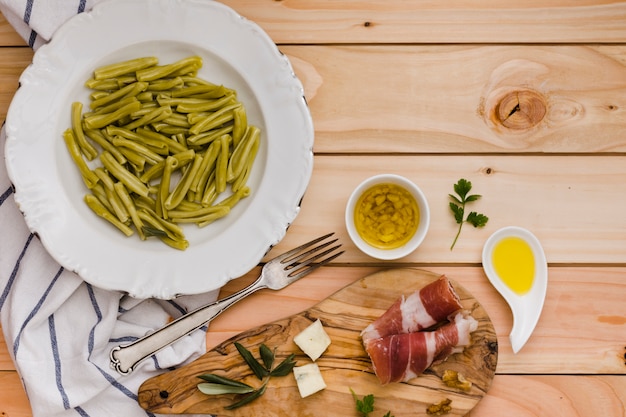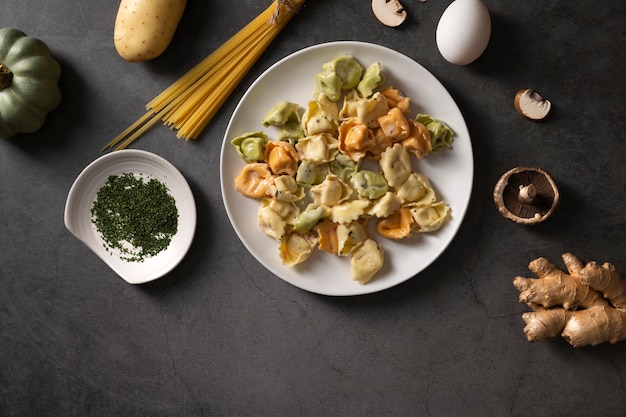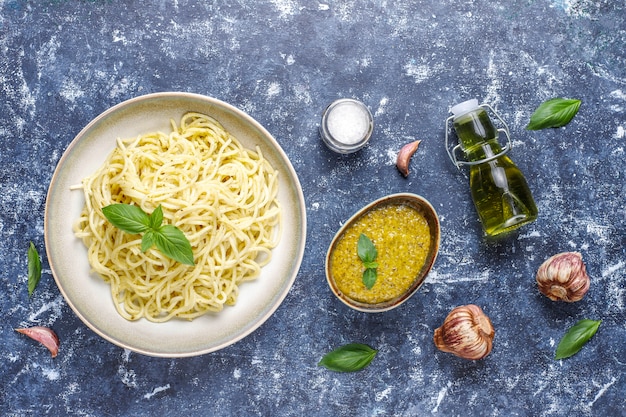Let's be honest, there's nothing quite like a plate of perfectly cooked pasta tossed in a vibrant, fragrant pesto. It's a dish that transports you straight to a sun-drenched Italian piazza, where the air hums with the scent of fresh basil and the clinking of glasses. And the best part? You don't need to be a culinary maestro to create this magic in your own kitchen. Homemade pesto is surprisingly simple, and once you've mastered the basics, you'll never want to go back to that jarred stuff.
I remember the first time I tried to make pesto. I was so intimidated by the fancy name and the seemingly complex ingredients. I thought it was something only Michelin-starred chefs could pull off. But trust me, it's as easy as whipping up a cup of tea (and way more delicious). You just need a few key ingredients, a blender, and a dash of confidence.
So, let me take you on a culinary adventure, where we'll unlock the secrets of pesto-making, transforming you from a pesto novice to a pesto pro. We'll delve into the essential ingredients, explore different pesto variations, and even uncover some insider tips and tricks. By the end, you'll be whipping up batches of homemade pesto with the confidence of a seasoned chef.
(Part 1) The Pesto Powerhouse: Essential Ingredients

To embark on this pesto journey, you need a handful of essential ingredients. Think of them as the core players in a culinary symphony, each contributing its unique flavour and texture to the final masterpiece.
1. Fresh Basil: The Green Heart of Pesto
First and foremost, you need fresh basil. This aromatic herb is the soul of pesto, lending its bright, herbaceous flavour and vibrant green hue. Look for basil leaves that are vibrant green, with no signs of browning or wilting. If you're lucky enough to have a local farmers market, it's a great place to find the freshest basil. Avoid basil that has been sitting on supermarket shelves for too long, as its flavour will be diminished.
2. Pine Nuts: Crunch and Nutty Delights
Next up, we have pine nuts. These tiny, nutty gems add a delightful crunch and a rich, earthy flavour to the pesto. While pine nuts are the traditional choice, you can also use walnuts or almonds as substitutes. If you're feeling adventurous, try toasted hazelnuts or pecans for a unique flavour profile.
3. Garlic: A Pungent Punch
No pesto would be complete without garlic. It's the ingredient that adds a powerful, pungent flavour that cuts through the richness of the other components. Don't be shy with the garlic; use enough to give your pesto a good kick.
4. Parmesan Cheese: Salty, Cheesy Perfection
Parmesan cheese is the finishing touch, adding a salty, cheesy depth that complements the basil and pine nuts beautifully. Look for a high-quality, grated Parmesan cheese that's free from additives. If you're lactose intolerant, you can use a vegan parmesan cheese substitute.
5. Olive Oil: The Flavorful Binder
Finally, we need olive oil. A good quality extra virgin olive oil is essential for a truly delicious pesto. It binds all the ingredients together, adds a subtle fruity flavour, and helps create the creamy texture we crave.
6. Salt and Pepper: The Essential Seasoning
Remember, a pinch of salt and pepper is crucial to balance the flavours and bring out the best in each ingredient.
(Part 2) The Pesto Making Process: Simple Yet Satisfying

Now that we've gathered our ingredients, let's embark on the pesto-making process itself. This is where things get exciting, as we transform our humble ingredients into a vibrant sauce that will tantalize your taste buds.
Step 1: The Blender Blitz
First, grab your trusty blender or food processor. You'll be using this trusty machine to pulverize the ingredients into a smooth, vibrant paste. Add the basil leaves, pine nuts, garlic cloves, Parmesan cheese, and a pinch of salt and pepper.
Now comes the fun part: blending! Pulse the blender or food processor several times until the ingredients are well combined. You want a smooth, paste-like consistency, but don't overblend. A bit of texture is a good thing, as it adds a satisfying crunch to the final pesto.
Step 2: The Oil Drizzle
With the base of our pesto ready, we need to add the olive oil. This is where patience comes in. Gradually drizzle the olive oil into the blender while it's running. This ensures that the oil is evenly incorporated and creates the desired creamy texture.
As you're adding the olive oil, taste the pesto. Adjust the seasoning with more salt, pepper, or Parmesan cheese if needed. Remember, your pesto should reflect your personal taste preferences.
Step 3: A Final Taste Test and Storage
Before you declare your pesto masterpiece complete, do a final taste test. Adjust the seasoning one last time, adding more salt, pepper, or Parmesan cheese as needed. Once you're happy with the flavour, your pesto is ready to enjoy!
You can store your freshly made pesto in an airtight container in the refrigerator for up to a week. For longer storage, freeze it for up to three months. Simply thaw it in the refrigerator overnight before using.
(Part 3) Pesto Pasta: A Match Made in Heaven

Now, for the moment we've all been waiting for: Pesto pasta! This iconic combination is a culinary classic for a reason. It's simple to prepare, incredibly tasty, and always satisfying. I've got two favourite ways to make pesto pasta, each with its own unique charm.
Option 1: The Classic Method
This is the tried and true method, the one you'll find in countless cookbooks and online recipes. It's quick, easy, and always delivers a delicious result.
- Cook your pasta according to the package instructions. I love using spaghetti, but feel free to experiment with other shapes like fettuccine or linguine.
- Once the pasta is cooked, drain it and immediately toss it with your homemade pesto. The heat of the pasta helps to meld the flavours of the pesto.
- For an extra touch of indulgence, drizzle a bit of olive oil on top and sprinkle with some grated Parmesan cheese.
Option 2: The Garlic Bread Method
This method adds a touch of culinary flair by incorporating toasted garlic bread. It's a bit more involved, but the extra flavour and texture are well worth the effort.
- Cook your pasta according to the package instructions.
- While the pasta is cooking, toast some slices of bread. I prefer using sourdough for its robust flavour and texture.
- Once the bread is toasted, rub each slice with a cut garlic clove. This step adds a fragrant, garlicky aroma to the bread. You can adjust the amount of garlic to your liking.
- Add a drizzle of olive oil to the cooked pasta, along with a generous amount of pesto. Stir well to combine the flavours.
- Toss in the toasted garlic bread and continue to stir until the bread starts to break down into delicious, garlicky crumbs.
- Serve the pasta immediately, while the bread is still warm and the flavours are at their peak.
(Part 4) Pesto Beyond Pasta: A World of Culinary Possibilities
While pesto pasta is a classic, don't limit your pesto adventures to just pasta. This versatile sauce can elevate a wide range of dishes, adding flavour and flair to your culinary creations.
1. Pesto as a Dip
Pesto makes a wonderful dip for breadsticks, vegetable crudités, or crackers. It's a delicious and healthy alternative to store-bought dips.
2. Pesto on Sandwiches
Spread a layer of pesto on your favourite sandwich for a burst of flavour. It complements grilled chicken, roasted vegetables, and even cheese sandwiches.
3. Pesto as a Sauce for Chicken or Fish
Brush pesto on chicken breasts or fish fillets before grilling for a delicious and aromatic flavour. The basil and garlic infuse the chicken or fish with a delightful herbal note.
4. Pesto as a Pizza Topping
Swap out tomato sauce for pesto on your next pizza. The basil and garlic create a unique flavour combination that will tantalize your taste buds.
5. Pesto as a Filling for Ravioli or Tortellini
Mix pesto with ricotta cheese and use it as a filling for ravioli or tortellini. This creates a delicious and flavourful filling that will elevate your pasta dishes.
(Part 5) Tips and Tricks: Mastering the Art of Pesto-Making
Now that you're well-versed in the basics of pesto-making, let's explore some insider tips and tricks that will take your pesto game to the next level.
Tip 1: Freshness is Key
The key to a truly delicious pesto is using the freshest ingredients possible. This is especially important for the basil, as its flavour diminishes over time. Look for basil leaves that are vibrant green and free from any brown spots or wilting.
Tip 2: Don't Overblend
While you want your pesto to be smooth and creamy, you don't want to overblend it. A bit of texture adds a satisfying crunch. If you overblend, your pesto will end up too smooth and lose its characteristic texture.
Tip 3: Store it Right
Pesto will keep well in the fridge for about a week, but for longer storage, freeze it in an airtight container for up to three months. To thaw, simply leave it in the refrigerator overnight.
(Part 6) Going Beyond Basic Pesto: Exploring Flavor Variations
Now that you've mastered the basic pesto recipe, let's explore some exciting variations that will add a touch of creativity to your culinary repertoire.
Pesto Variations
- Sun-dried Tomato Pesto: Add a handful of chopped sun-dried tomatoes to your pesto for a burst of sweet and tangy flavour.
- Lemon Pesto: Zest and juice a lemon and add it to your pesto for a bright and citrusy flavour. This variation is a perfect complement to seafood.
- Roasted Red Pepper Pesto: Roast red peppers until they're soft and blistered, peel them, and add them to your pesto for a smoky and slightly sweet flavour.
- Pistachio Pesto: Swap out the pine nuts for pistachios for a slightly sweeter and more delicate flavour.
- Spinach Pesto: If you're not a fan of basil, try using spinach instead. It's a great way to sneak in some extra greens.
(Part 7) The Pesto You've Been Waiting For: A Signature Recipe
This is my go-to pesto recipe, the one I make time and time again. It's simple, delicious, and always a crowd-pleaser.
Ingredients:
- 2 cups of fresh basil leaves
- 1/2 cup of pine nuts
- 3 cloves of garlic
- 1/2 cup of grated Parmesan cheese
- 1/2 cup of extra virgin olive oil
- Salt and pepper to taste
Instructions:
- Combine all ingredients in a blender or food processor.
- Blend until smooth, adding olive oil a little at a time until you reach your desired consistency.
- Taste and adjust seasoning as needed.
- Serve immediately or store in an airtight container in the fridge for up to a week.
(Part 8) From Pesto Newbie to Pesto Pro: A culinary journey
Congratulations! You've now completed your pesto journey, transforming from a novice to a pesto-making pro. You've explored the essential ingredients, mastered the blending process, and learned about countless pesto variations. The world of pesto is your oyster, ready to be explored with your newfound culinary confidence.
So, go forth and create! Whip up batches of homemade pesto, impress your friends and family with your newfound culinary skills, and savor the joy of homemade goodness. After all, there's nothing quite like the satisfaction of creating a delicious and flavourful dish from scratch.
FAQs
Q1: What kind of pasta goes best with pesto?
It's really up to personal preference, but I find that spaghetti, fettuccine, or linguine work really well, as they have enough surface area for the pesto to cling to.
Q2: Can I make pesto ahead of time?
Absolutely! It's actually best to make it ahead of time, as the flavours have a chance to meld together. Store it in an airtight container in the fridge for up to a week.
Q3: What if I don't have pine nuts?
No worries, you can use other nuts like walnuts, almonds, or even cashews. Just make sure you toast them slightly in a dry pan before adding them to the blender.
Q4: How can I keep my pesto from separating?
The trick is to blend the pesto until it's really smooth. And don't forget to add the olive oil gradually while the blender is running.
Q5: What are some other ways to use pesto?
Pesto is incredibly versatile. You can use it as a dip, a spread, a sauce, a topping, or even a filling. Get creative and experiment!
Everyone is watching

How to Cook Frozen Lobster Tails Perfectly: A Step-by-Step Guide
RecipesLobster. Just the word conjures up images of lavish meals, special occasions, and a taste of luxury. But let's...

Pigs in a Blanket Cooking Time: How Long to Bake for Perfect Results
RecipesAh, pigs in a blanket. Just the name conjures up images of those delightful little parcels of crispy pastry en...

Pork Fillet Cooking Time: How Long to Cook It Perfectly
RecipesPork fillet, or tenderloin as it's sometimes called, is a real favourite in our house. It's so versatile, and...

The Ultimate Guide to Tender, Juicy Pulled Pork
RecipesRight, let's talk pulled pork. It's one of those dishes that just screams "comfort food," doesn't it? I mean...

The Ultimate Guide to Cooking Sweet Potatoes: From Roasting to Mashing
RecipesSweet potatoes. Just the name conjures up images of warm, comforting dishes, bursts of vibrant color, and a to...
